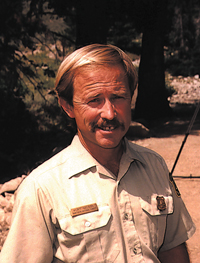Idaho has had a relatively calm fire season, but that doesn't mean it hasn't been smothered in smoke blown in from California since early July. Nor does it mean Idaho's federal agency budgets aren't going to be impacted by the ever-rising costs associated with combating the California flames.
Congress budgeted $1.2 billion for the Forest Service to combat fires this year. Current estimates have that figure climbing as high as $1.6 billion. The entire agency will tighten its belt to make up the difference, and in the Wood River Valley that means some projects will not be completed as planned.
"We were notified about two weeks ago, around Aug. 4, that fire transfer was imminent," said the Sawtooth National Forest's Ketchum District Ranger Kurt Nelson.
Last week the U.S. Forest Service issued an agency-wide order to compile unallocated funds to be sent to help combat the California fires. The money is to be sent to California in four, $100 million installments.
"We're doing fire borrowing," said Sawtooth National Forest spokeswoman Alicia Bennett. "It's the first time we've done this since 1995."
Bennett said the Intermountain Region of the Forest Service has been asked to kick in $16 million. It is as yet unclear how much of that $16 million will be culled from local forest budgets in Central Idaho.
"Each region is given the amount of money they have to come up with," Bennett said. "Then the region tells each of the forests what their share of the regional amount is. Right now we really don't know what the forest share is."
The Forest Service has struggled for years to pay for fighting fires that last year alone scorched nearly 10 million acres. As fire seasons grow longer and fires burn with more intensity in forests stressed by global warming the agency's funding woes mount.
The problems this year are despite rising Forest Service fire fighting budgets. In 1998 10 percent of the agency's budget was allocated to fight fires. This year that amount had climbed to 45 percent, and still that was not enough.
"It's coming out of everybody's budget," Bennett said.
Non-emergency contracts are being pulled. Meetings, including conferences and educational seminars for employees, are being scrapped. No hiring will occur.
"At this point the option the agency has in terms of protective fire costs, we have to look at how we're going to cover that shortfall and that's to use the transfer authority and shift money from other programs to cover the estimated fire suppression cost," Nelson said.
Last year, too, the agency exceeded its fire budget, Nelson said, but Congress allocated emergency spending before it adjourned for its August recess.
Now, forest managers are looking at pinching pennies, and for Nelson that means looking at money that was allocated to help rehabilitate portions of the Ketchum Ranger District that burned last year in the Castle Rock Fire.
"We're going to be looking at whatever dollars we have not obligated or spent to date," Nelson said. "Se we've got several projects we planned on accomplishing in August and September. Those will be put on hold or deferred until fiscal year 2009, which starts Oct. 1."
For now, fire suppression costs in California continue to mount at $13 million per day. What's more, the fire season in certain portions of the Rocky Mountains, like Idaho, has only just begun.
"It's a rapidly evolving situation," Nelson said. "As the chief said, 'pray for rain.'"
As of August 5, 900,000 acres of Forest Service land had burned, up 100,000 acres from the same time a year ago.


 Kurt Nelson
Kurt Nelson



































